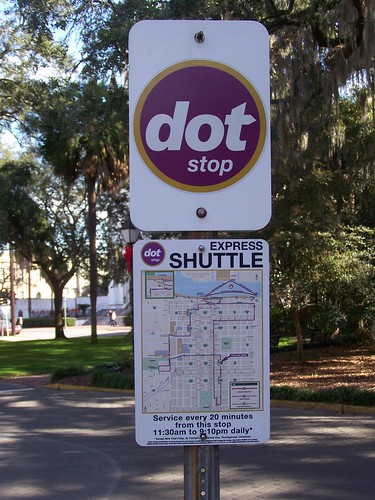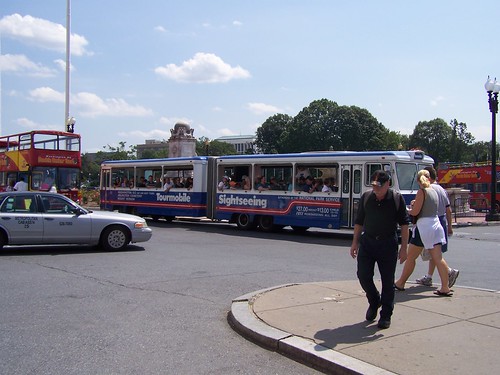One of the problems with planning in DC is the federal interest is planned separately from the local interest, and yet the interests are intertwined. This isn't a problem with land use generally, because the National Capital Planning Commission plans for the general federal interest, and produces "
Federal Elements" for the
City's Comprehensive Land Use Plan.
Although the disconnection is demonstrated by the failure of the city's Comp. Plan webpage to link to the Federal Elements webpage of the NCPC webpage, although they do acknowledge the Federal Elements. On the other hand, NCPC's page provides a link to the DC Comp. Plan webpage.
Where the problems come up have to do with parks planning and transportation planning especially.
Many of the "city" parks are under federal control by the National Park Service--and the parks are used by people who come to visit the city, including demonstrations, which they do not because Washington is "cool" but because it is the national capital of the USA, and to visit the institutions and monuments that are located here as a result. But these parks also serve local audiences, in particular DC residents.
Note that DC, NPS, and the NCPC joined together to do a parks plan of a sort, called
Capital Space, but I don't think of that plan as a comprehensive parks and recreation plan jointly planning federal and local parks assets within the city in an integrated fashion as much as it is a grab bag of some things that needed to be addressed.
As far as transportation planning is concerned, because most of these monuments and institutions where visitors go are in the federal interest area, for the most part DC doesn't attempt to plan there, with the exception of a plan to put a Circulator bus system on the National Mall and attempts, now successful, to get the National Park Service to agree to put bike sharing stations on the National Mall, which heretofore they had resisted.
Top "DC" destinations for tourists (not ranked)
White House
US Capitol
Washington Monument
National Mall/Smithsonian Museums/National Gallery
Mount Vernon
Alexandria (commercial district)
Georgetown (commercial district)
Arlington Cemetery
Note that on their visits, non-business visitors tend to stay overnight in suburban motels, which are cheaper than most lodging options in DC, which further stresses the transportation system.
Note that WMATA is considering a new fare system which would eliminate "tourist" passes--further making bikesharing a legitimate form of transportation for visitors, but children under 16 years of age aren't supposed to use these bikes.
On the other hand, visitors that come to the city on business (lobbying etc.) tend to stay in the city, unless their associations and such are based in the suburbs, e.g., the City of Alexandria is the location for many associations, and many federal agencies, such as the Pentagon, are located in the suburbs.
DC doesn't have a master transportation plan really (other than the documents required by the US DOT), although it is about to produce one, and there is the Transportation Element of the Comp. Plan.
NCPC does have a
Visitor Element in their Comp. Plan. DC doesn't have an equivalent element in its Comp. Plan although I've argued for one for a few years, in part because of learning that
Charleston, SC has one, although the plan isn't online, the ordinance is, but I'd say it doesn't read as well as the NCPC's element. The NCPC element isn't just on transportation, it's also about the quality of the experience overall, although it remains for other federal agencies to implement those concepts, and for the most part they don't...
The National Park Service did a transportation plan a few years ago and is about to go through another iteration imminently. Plus the issue of the Tourmobile bus service, which I've written about over the years, and was covered very well by the
Washington City Paper Housing Complex blog, such as in "
The Never Ending Tourmobile."
A letter in today's
Post, "
Lack of transit options put Mall sites at a distance," illustrates the necessity of having an integrated federal-city visitor-focused transportation plan, to serve the millions of visitors that come to the city annually. From the letter:
My niece was visiting recently, and she wanted to see several buildings and monuments in Washington. We took the Metro to the Capitol, the Library of Congress and the U.S. Botanic Garden. This required a lot of walking, and the day was a bit windy and cold. The next part of our trip was to the carousel on the Mall, which she rode 40 years ago as a child.
We suddenly realized that there was no easy way to get there, and it was shocking to feel stranded in the middle of the District. I was uncertain about the Metrobus schedule and routes, and we would have had to walk quite a distance to get to a bus. We did not want to take a taxi, so we walked.
In the end, my niece dropped her plan to see the Martin Luther King Jr. Memorial, the Lincoln Memorial, the Jefferson Memorial, the Vietnam Veterans Memorial and the other memorials in that area of the Mall. It felt strange, and hard to believe, that we could not visit these memorials because we did not want to ride one of the hop-on/hop-off sightseeing buses.
Tourists shouldn’t be forced to take expensive sightseeing buses to see D.C. attractions. In hindsight, I suppose we could have taken a cab to see the memorials, but that would have still left us with quite a hike between some of the memorials. There should be another way for tourists to easily and inexpensively get around the Mall. DOT transportation street sign, with map of the streetcar, shuttle bus, and water taxi services, Savannah, Georgia.
DOT transportation street sign, with map of the streetcar, shuttle bus, and water taxi services, Savannah, Georgia.
I was in Savannah for the holidays, and I discovered that Savannah created a visitor mobility plan in 2005, which called for various city mobility initiatives--a short distance streetcar on River Street (the route could be extended over time), water taxi service from the River Street District to the convention center across the Savannah River on Hutchinson Island, and a bus shuttle service between parking garages and certain activity centers downtown. This is complemented by 4 existing free shuttle routes through the downtown area run by the local transit system.
Savannah's mobility initiative, DOT, is paid for mostly by tourism taxes and revenues from the parking structures. To limit congestion--the roads are narrow and the blocks are short, limiting queuing capacity, visitors (and commuters) are encouraged to park at the parking structures--they aren't the prettiest things--and to walk and use the free transit services.
Unlike a lot of communities, the rate for parking is relatively inexpensive, $7 for one day or $12 for a two day pass.

There is still metered street parking, and there are other restrictions, not unlike how DC's performance parking district and residential parking permit restrictions favor residents over visitors--giving a two hour daily limit for free parking in these areas.
They even have a training program for front line staff:
--
MOBILITY FRONT LINE TRAINING REFERENCE MANUALThe letter to the editor reminds me of a conversation I had with another tourism person years ago, but he was recounting his experience visiting DC with his aged mother. He said "there aren't places to sit in Washington, I had to buy her a chair that we carried around with us."
And it also reminds me of how Tyler Brule, the publisher of
Monocle magazine and a columnist in the
Financial Times, always complains about the quality of the experience at Dulles Airport, e.g., "
High anxiety and buses on stilts."
And how Union Station and National Airport aren't managed in ways that provide quality customer experiences either.
The coming development of a city master transportation plan is an opportunity to raise and address these issues. And the Savannah Visitor Mobility Plan is a good model to start with, although for DC, the Capital Bikeshare program would be another element, see "
Bikeshare: More of a Tourist Thing Than I Realized" from the
City Paper Housing Complex blog.
Labels: tourism, transportation planning, urban design/placemaking, visitor services






0 Comments:
Post a Comment
<< Home